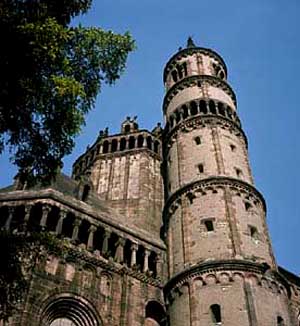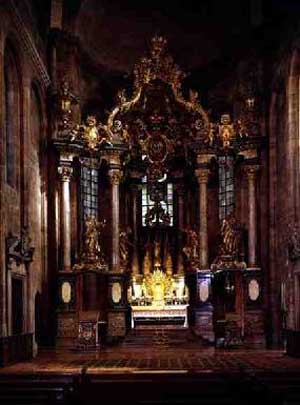 |
Art & Architecture
Gothic Riches
Hugh O’Reilly
The medieval epoch was one of profound intellectual movement. Giant souls like Gregory VII and so many of the monks of Cluny labored to achieve the highest of aims. In the Church-State controversy, the most transcendent questions were dealt with.

The Cathedral of Worms, 1171-1220.
An ethereal light filters onto the main altar, below
 |
Although the historical works rarely spoke of the intellectual life of this epoch, the buildings of the period spoke of it, as written carved letters impressed into the lives of those peoples. Despite all the fights, all the calamities and natural phenomena that decimated the population – with bodies at times over-spilling the cemeteries; despite the expense of human energies and money that flowed to the East with the Crusades, many beautiful and original edifices were constructed in this period.
The Romanesque style achieved its perfection, and the Gothic or Norman saw its splendid start. In art the Christian ideals were victorious. Among the Franks [and Germans], the Roman style thrived, principally along the Rhine - the Cathedrals of Speyer, Mainz and Worms. Through William the Conqueror, the Gothic came to flourish in Normandy and England, and from there, extended throughout the greater part of Europe.
While the Romanesque arch permits only a limited height, the Gothic arch adapts itself to the most powerful and audacious buildings. However high and heavy the ceiling may be, it nonetheless seems light and lofty. The slender columns rise from the earth, interlacing each other naturally and rising to display a kind of foliage ceiling of a stone forest.
The whole construction, which took its shape of a cross from the basilica, is steeped in a profound symbolism. The eagle is the image of the soul that rises to God; the hart, of the soul that thirsts for truth. The rose over the threshold is the symbol of silence and signifies that in the sacred space of the church every worldly thing must be silent. Through the tall windows an ethereal light filters through, a light different from that of the material sun. The monster gargoyles used on the external part as gutters remind us that even evil must serve the good…
The interior spaces are ample; waves of people come and go. Here a Baptism takes place, there a Communion is given, at the side chapels private devotions are practiced. As an image of the Catholic Religion, the edifice aspires to encompass the whole world.

Translated and based upon
John Baptist Weiss, História Universal,
Spanish edition, Barcelona: Aviñé, vol. 5, pp. 179-182.
Posted March 28, 2009

Related Topics of Interest
 The Gargoyle: Vigilance in Symbols The Gargoyle: Vigilance in Symbols
 The Cathedral: Symbol of Paradise The Cathedral: Symbol of Paradise
 The Middle Ages, a Forest Filled with Symbols The Middle Ages, a Forest Filled with Symbols
 Requiescant in Pace... Burial Customs Requiescant in Pace... Burial Customs
 The Symbol of the Sword The Symbol of the Sword
 Virtue and Vice Symbolized in Animals Virtue and Vice Symbolized in Animals
 Clash of Gothic and Cartesian Mentalities Clash of Gothic and Cartesian Mentalities
 St. Peter & the Vatican Exhibit: Marvelous Continuity, Shocking Change St. Peter & the Vatican Exhibit: Marvelous Continuity, Shocking Change

|
Art & Architecture | Hot Topics | Home | Books | CDs | Search | Contact Us | Donate

© 2002-
Tradition in Action, Inc. All Rights Reserved
|
 |

|